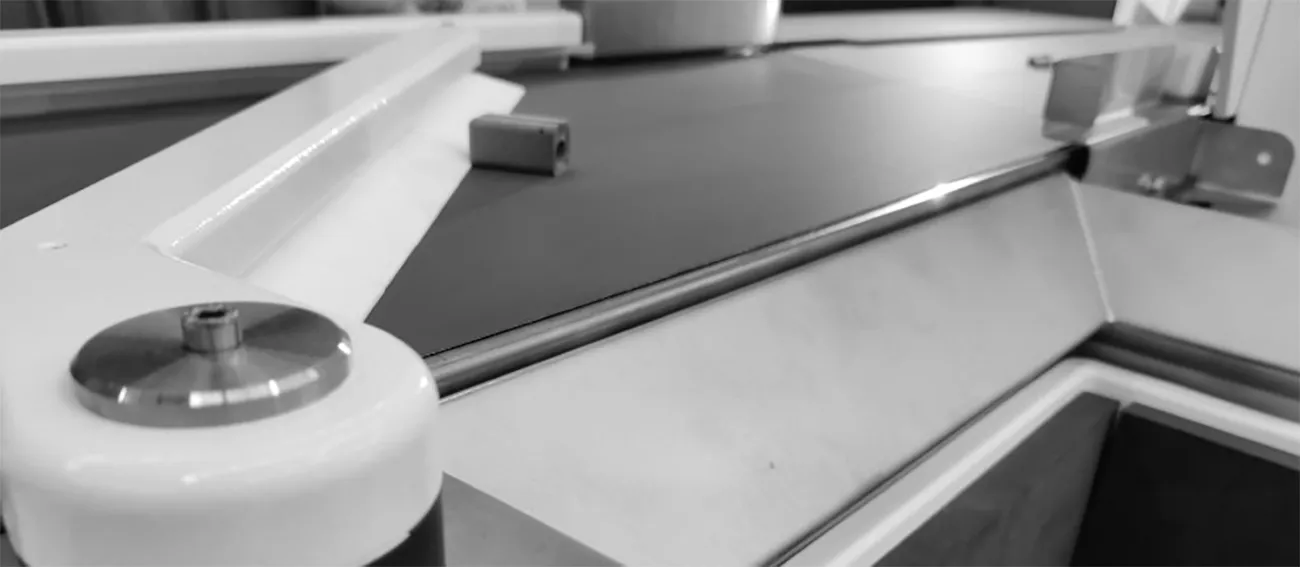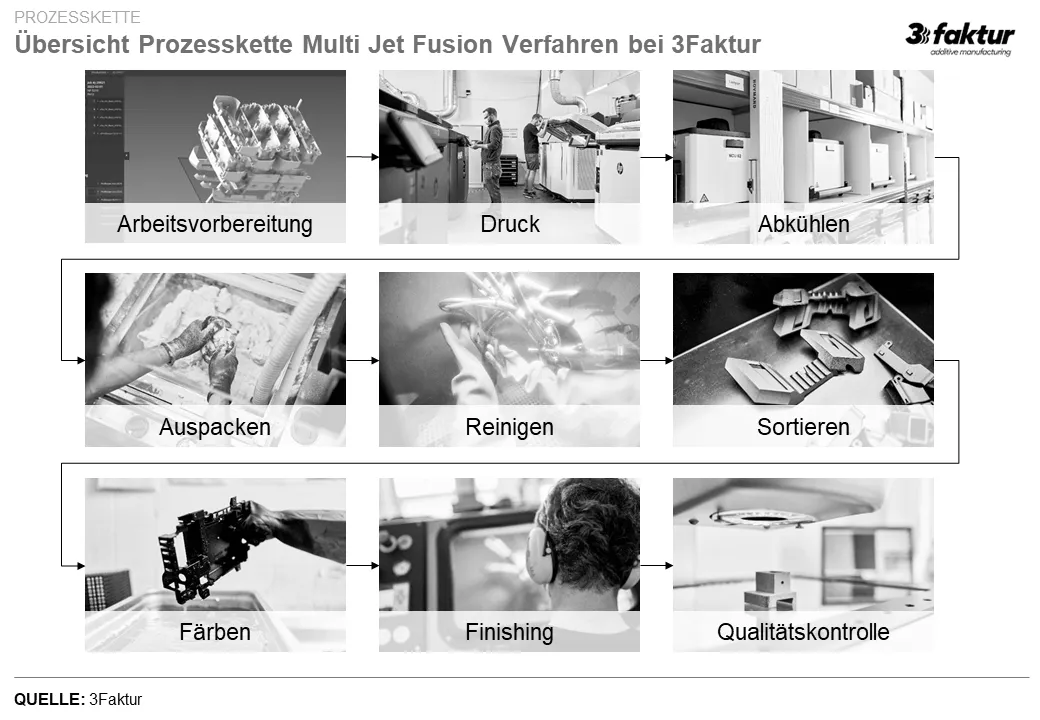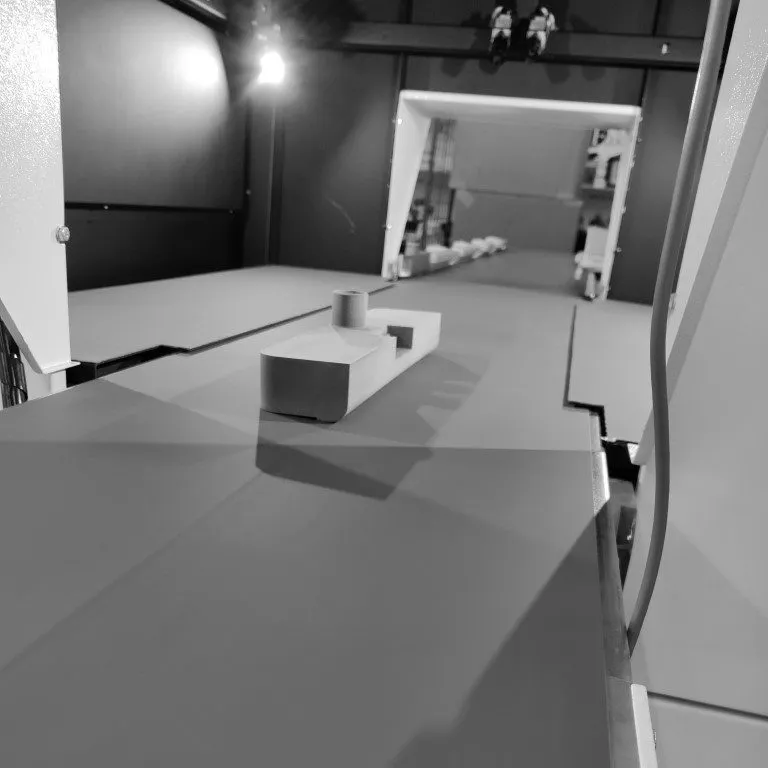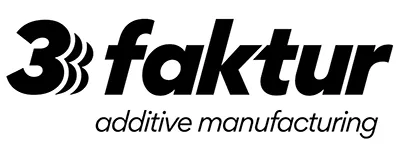
3D printing was originally a prototyping technology aimed at producing components as close to serial parts as possible. Consequently, a wide range of additive technologies and materials was necessary to achieve this goal. This technological diversity, which sometimes also required retrofitting equipment for material changes, made automation in prototyping technically complex and economically unfeasible.
However, with the trend towards series production, production-oriented facilities emerged with a significantly lower number of technologies and materials. For example, 3Faktur, as a contract manufacturer, exclusively operates with the Multi Jet Fusion technology (“MJF”). Similarly, the US company “Smile Direct Club” also operates with the same technology and has the largest global capacity of MJF printers to produce aligners for dentistry.
As industrial component quality and economical price levels are now being achieved with quantities up to a few thousand, automation is becoming increasingly worthwhile.
Initial situation: Additive manufacturing with complex process chains
There are numerous additive manufacturing processes that differ significantly in the printing and subsequent process chain. Consequently, automation looks different for each technology.
Here, for example, the Multi Jet Fusion process (“MJF”) is described, which is one of the most powerful processes in additive plastic processing. The process chain largely corresponds to that of laser sintering, which is also a widely used powder-based 3D printing technology. The MJF process consists of 9 process steps, which are shown in Figure 2.
The process is resource-intensive because each component must be processed multiple times – digitally before 3D printing and physically after 3D printing. The process chain is thus a significant cost driver and therefore also an obstacle to the production of larger quantities. However, automating the process chain and the resulting efficiency gains can enable the economic viability of larger quantities.

Where We Stand Today: (Partial) Automation of Sub-Processes
In recent years, there has been a significantly greater focus in the industry on the process chain. There are now several companies offering AM-specific solutions, such as:
- Dyemansion, Germany: Equipment for cleaning, dyeing, and surface treatment (shot peening & chemical smoothing) focusing on powder-based plastic processes.
- AMT, UK: Equipment for component cleaning and surface treatment (chemical smoothing) focusing on powder-based plastic processes.
- MHG Strahlanlagen, Germany: Component cleaning and shot peening.
- AM-Solutions, Germany: Equipment especially for component cleaning and surface finishing (shot peening, tumbling, among others) predominantly for additive plastic manufacturing (powder, photopolymer, and FFF/FDM).
- Post Process, USA: Covers a similar field to AM-Solutions but with partly different solutions.
- AM Flow, Netherlands: Component recognition, sorting, and packaging.
These companies have developed solutions to automate individual process steps and thus, depending on the solution, significantly increase efficiency. However, the developed solutions are currently not integrated, so each step still requires manual work – for example, loading, pre- and post-processing, and maintenance of the individual systems.



Where We’re Headed: Integrated Process Chains and the “Lights-Out Factory”
Maximum efficiency enhancement can only be achieved if the entire process chain of additive manufacturing is automated. To achieve this, numerous projects are underway internally within companies and also in cross-company consortia.
However, there are some hurdles to overcome, such as:
- Non-automatable Sub-Processes: Some steps are not or only with considerable, economically impractical effort automatable. An example of this is the pre- and post-processing as well as cleaning of equipment. This also includes the 3D printers, which become heavily soiled during powder printing and need to be thoroughly cleaned accordingly.
- Loading: Loading the equipment along the process chain is often (currently) not designed for automation, requiring extensive modifications or customized solutions.
- Interfaces: Automation requires integrated IT. This is a challenge when working with equipment from multiple manufacturers. Often, the equipment only has rudimentary or no interfaces at all, necessitating complex adaptations of the equipment or automation solutions.
- Quality: Each process step generates typical sources of errors, which are identified by workers through visual inspection (for surface defects) or using measuring instruments. Automation of this process poses sometimes significant technical challenges. For example, component cleaning and removal of remaining powder in blind holes and channels, which can be reliably detected by experienced workers. Due to the often hard-to-reach areas, automated quality control, such as camera-based inspection, poses a considerable challenge.
Sie sehen gerade einen Platzhalterinhalt von Standard. Um auf den eigentlichen Inhalt zuzugreifen, klicken Sie auf den Button unten. Bitte beachten Sie, dass dabei Daten an Drittanbieter weitergegeben werden.
Weitere InformationenVideo 1: Presentation of a future vision of additive manufacturing by equipment manufacturer EOS.
Does this mean the dream of the “Lights-Out Factory” is shattered? No, but on the way there, one should not expect a revolution but rather an evolution. There are sub-steps that are already economically integrable today. These will be increasingly implemented in the coming years.
At 3Faktur, for example, we are working on the following projects:
- Integration of component cleaning with automated sorting
- Integration of dip dyeing with automatic sorting as an integrated and automated process chain
- Automatic, in-line (conveyor-based) quality control (dimensional accuracy inspection)
- Automation of job preparation using artificial intelligence
More complex sub-steps, such as visual inspections or the cleaning and loading of some equipment, will be gradually improved in new generations of equipment. Similar developments are also expected in IT: Until a few years ago, interfaces were the exception, but with new equipment, such functionality is already standard.
To achieve a similar level of automation as in conventional manufacturing, it will take several more years. However, in the coming years, the process chain will become increasingly integrated, making additive manufacturing competitive in areas that cannot currently be served.

About 3Faktur: 3Faktur specializes in 3D printing, rapid prototyping, and rapid manufacturing. We utilize HP’s Multi Jet Fusion technology and offer various materials for prototyping and series production. If you have any questions about your project, feel free to contact us.
